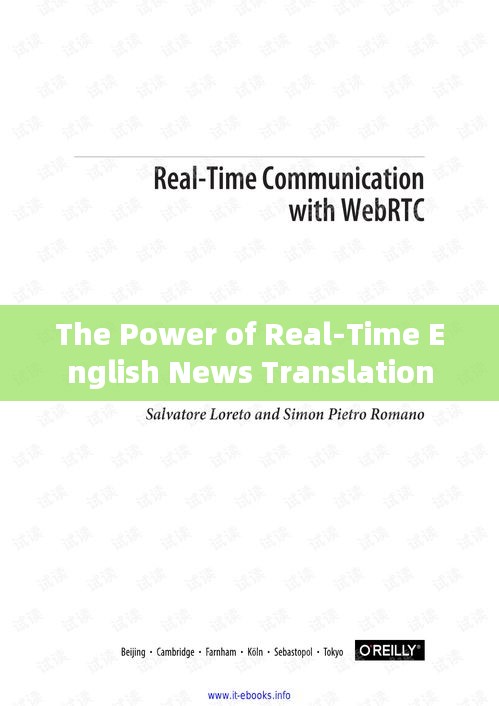The Power of Real-Time English News Translation
In the fast-paced world we live in, staying informed about global events is crucial. However, not everyone is fluent in English, the primary language of international news. This is where real-time English news translation comes into play, bridging the language gap and providing access to information for a wider audience. This article explores the benefits, challenges, and future of real-time English news translation.
The Need for Real-Time Translation
The Growing Demand for Multilingual News
The world has become more interconnected than ever before. With the advent of social media and global news networks, people are exposed to news from all corners of the globe. However, not everyone can understand the language in which the news is presented. This has led to a growing demand for real-time translation services that can break down language barriers and make news accessible to a multilingual audience.
According to a report by Common Sense Media, 40% of American adults speak a language other than English at home. This statistic highlights the need for real-time translation services that can cater to this diverse population. By providing instant translations, news organizations can ensure that their content reaches a wider audience, thereby increasing their reach and influence.
How Real-Time Translation Works
Technological Advancements in Translation
Real-time English news translation relies on advanced technologies such as artificial intelligence (AI) and machine learning (ML). These technologies enable machines to understand and interpret human language, making it possible to translate news content in real time.
Machine translation systems work by analyzing the text, identifying the language, and then converting it into the desired language. This process involves several steps, including language detection, tokenization, morphological analysis, syntactic analysis, and finally, the generation of the translated text.
One of the most popular real-time translation services is Google Translate, which uses neural machine translation (NMT) to provide accurate and fast translations. Other services, such as Microsoft Translator and DeepL, also utilize NMT to offer real-time translation solutions.
Benefits of Real-Time English News Translation
Enhanced Accessibility and Inclusivity
Real-time English news translation has several benefits, the most significant of which is enhanced accessibility and inclusivity. By making news content available in multiple languages, news organizations can cater to a diverse audience, including those who are non-native English speakers.
Moreover, real-time translation services can help break down political and social barriers. For instance, during international conflicts or crises, real-time translations can ensure that people from different countries can access and understand the information being shared, fostering a sense of global community and empathy.
Increased Audience Reach
Another benefit of real-time English news translation is the potential to increase an organization's audience reach. By providing content in multiple languages, news organizations can tap into new markets and attract a broader demographic.
For example, a news website that offers content in English, Spanish, and French can reach a much larger audience compared to one that only offers English content. This can lead to increased engagement, higher website traffic, and potentially, more advertising revenue.
Challenges and Limitations
Accuracy and Contextual Understanding
While real-time translation services have come a long way, they still face challenges in terms of accuracy and contextual understanding. Machine translations can sometimes miss nuances, idioms, and cultural references, leading to misinterpretations.
Moreover, real-time translation services may struggle with complex language structures, technical jargon, and specialized terminology. In such cases, human translators may be required to ensure the accuracy and quality of the translations.
Privacy and Security Concerns
Another challenge is the privacy and security concerns associated with real-time translation services. As these services often require access to sensitive data, there is a risk of data breaches and unauthorized access.
News organizations must ensure that their translation partners adhere to strict privacy and security protocols to protect their audience's data.
The Future of Real-Time English News Translation
Continuous Improvement and Human Oversight
The future of real-time English news translation lies in continuous improvement of AI and ML algorithms, coupled with human oversight. As these technologies evolve, they will become more accurate and efficient, reducing the need for human translators.
However, human translators will always play a crucial role in ensuring the quality and accuracy of translations, especially for content that requires a deep understanding of cultural nuances and context.
Integration with Other Technologies
Another trend in the future of real-time translation is the integration with other technologies, such as virtual reality (VR) and augmented reality (AR). This could enable immersive news experiences that cater to diverse linguistic audiences, making global news even more accessible and engaging.
In conclusion, real-time English news translation has the potential to transform the way we consume news, making
Navigating the Rails: Understanding Real-Time Train Information in English
The Art of Real-Time Translation at Business Recruitment Meetings
Title: Unveiling the Real-Time Traffic Congestion Rankings: A Comprehensive Look
The Evolution and Impact of Real-Time English Translation Software
The Rise of Real-Time Chinese to English Translation Apps
The Importance of Real-Time Currency Exchange Rates














 粤ICP备19130523号-1
粤ICP备19130523号-1